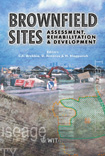Recovery Of Coal Tar In 1-D Column Test Using Surfactant Enhanced Aquifer Remediation (SEAR)
Price
Free (open access)
Transaction
Volume
55
Pages
Published
2002
Size
387 kb
Paper DOI
10.2495/BF020441
Copyright
WIT Press
Author(s)
S. Yoon, K. Kostarelos, & S. Urbanczyk
Abstract
Recovery of coal tar in l-D column test using surfactant enhanced aquifer remediation (SEAR) S. Yoon, K. Kostarelos, & S. Urbanczyk Department of Civil Engineering, Polytechnic University, USA. Abstract This paper presents the results of flow-through column testing using a new surfactant, Alfo-terra 123-8 PO sulfate, for the recovery of coal-tar from contaminated soil. Coal tar is a dense, non-aqueous phase liquid (DNAPL) that is difficult to recover due to its hydrophobic behavior and its high viscosity. Preliminary testing (phase behavior-batch tests) revealed a high degree of coal tar solubilization using a formulation of 12 wt.% Alfo-terra 123-8 PO sulfate surfactant, 4 wt.% secondary butanol, and 200 mg/L calcium chloride (as calcium). The formulation also exhibited rapid equilibration, without forming anisotropic gels. The column test was performed to verify compatibility of the formulation with the field-obtained DNAPL and soil. The column test was successful, resulting in low pressure drop, over 97 % coal tar recovery, with no visible gel formation nor any coal tar mobilized. This experiment showed good compatibility of the selected surfactant using field soil and field DNAPL, and should be studied further and considered for use in the field. 1 Introduction Generally, coal tar is a by-product from operations at manufactured gas, gas purification, gas storage, gas distribution, and coke production facilities [1,2]. Coal tar-a mixture of compounds-is a black, gooey, sludge-like material that smells like mothballs [l,2]. Coal tar has proven difficult to remove from soil due to its hydrophobic behavior and its high viscosity. It dose not easily dissolve in water, yet there is concern for potential ground water contamination because the presence of poly aromatic hydrocarbons (PAHs) that make-up coal tar have been
Keywords




